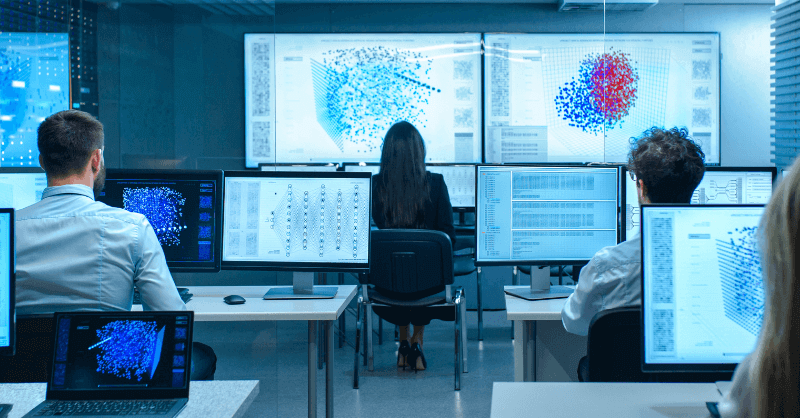Deep Learning & Neural Networks Python - Keras
Let your AI journey transcend new heights with our Deep Learning & Neural Networks Python – Keras course, your best path to mastering deep learning.
 Course Highlights
Course Highlights
Ever dreamt of navigating the intricate pathways of the human brain’s counterparts in the machine world? Welcome to the “Deep Learning & Neural Networks Python – Keras” course, an odyssey that paints a vivid picture of the intertwining webs of neural networks. Our meticulously crafted modules transport you from the foundational stones of Python basics straight into the high towers of Theano and TensorFlow library installations.
Transition smoothly from understanding the complex labyrinths of neural structures to implementing them with flair. Whether it’s the Pima Indian Diabetes or the Iris Flower Multi-Class models, we’ll unravel the steps, terminologies, and techniques with precision. Dive deeper into the shimmering waters of Convolutional Neural Networks, where you’ll gain first-hand knowledge on data giants like the MNIST Handwritten Digit Recognition and the CIFAR-10 Object Recognition Datasets.
As the cherry on top, our Deep Learning & Neural Networks Python course does not merely offer theoretical insights. Instead, we illuminate the path to applying these neural structures in tangible scenarios. From checkpointing neural network improvements to plotting model behavior history and understanding image augmentation, every corner you turn unveils another layer of deep learning wonder. Join us in this transformative journey and sculpt your future in the AI realm.
 Learning outcome
Learning outcome
- Differentiate between machine learning and deep learning in AI projects.
- Navigate through Python basics and library installations including Theano and TensorFlow.
- Develop and evaluate models including Pima Indian Diabetes, Iris Flower Multi-Class, and more.
- Gain proficiency in convolutional neural networks with insights on MNIST and CIFAR-10 Datasets.
- Apply knowledge in practical scenarios by loading and predicting various models.
- Understand the importance and application of dropout regularization and learning rate schedules.
- Effectively use checkpointing to improve and save neural network models.
 Course media
Course media
 Why should I take this course?
Why should I take this course?
- Comprehensive coverage of deep learning and neural networks.
- Step-by-step guide on developing and evaluating various models.
- Access to real datasets like MNIST and CIFAR-10.
- Insights on advanced concepts like dropout regularization and learning rate schedules.
- Learn how to use checkpointing to improve neural network models.
 Career Path
Career Path
- Data Scientist.
- Machine Learning Engineer.
- AI Research Scientist.
- Neural Network Developer.
- Deep Learning Specialist.
- Computer Vision Engineer.
 Requirements
Requirements
- Basic understanding of Python programming.
- Basic knowledge of machine learning concepts.
- Willingness to learn and apply new skills in deep learning.
 Course Curriculum
Course Curriculum
Course Curriculum
| Course Introduction and Table of Contents | |||
| Course Introduction and Table of Contents | 00:11:00 | ||
| Deep Learning Overview | |||
| Deep Learning Overview – Theory Session – Part 1 | 00:06:00 | ||
| Deep Learning Overview – Theory Session – Part 2 | 00:06:00 | ||
| Choosing Between ML or DL for the next AI project - Quick Theory Session | |||
| Choosing Between ML or DL for the next AI project – Quick Theory Session | 00:09:00 | ||
| Preparing Your Computer | |||
| Preparing Your Computer – Part 1 | 00:07:00 | ||
| Preparing Your Computer – Part 2 | 00:06:00 | ||
| Python Basics | |||
| Python Basics – Assignment | 00:09:00 | ||
| Python Basics – Flow Control | 00:09:00 | ||
| Python Basics – Functions | 00:04:00 | ||
| Python Basics – Data Structures | 00:12:00 | ||
| Theano Library Installation and Sample Program to Test | |||
| Theano Library Installation and Sample Program to Test | 00:11:00 | ||
| TensorFlow library Installation and Sample Program to Test | |||
| TensorFlow library Installation and Sample Program to Test | 00:09:00 | ||
| Keras Installation and Switching Theano and TensorFlow Backends | |||
| Keras Installation and Switching Theano and TensorFlow Backends | 00:09:00 | ||
| Explaining Multi-Layer Perceptron Concepts | |||
| Explaining Multi-Layer Perceptron Concepts | 00:03:00 | ||
| Explaining Neural Networks Steps and Terminology | |||
| Explaining Neural Networks Steps and Terminology | 00:10:00 | ||
| First Neural Network with Keras - Understanding Pima Indian Diabetes Dataset | |||
| First Neural Network with Keras – Understanding Pima Indian Diabetes Dataset | 00:07:00 | ||
| Explaining Training and Evaluation Concepts | |||
| Explaining Training and Evaluation Concepts | 00:11:00 | ||
| Pima Indian Model - Steps Explained | |||
| Pima Indian Model – Steps Explained – Part 1 | 00:09:00 | ||
| Pima Indian Model – Steps Explained – Part 2 | 00:07:00 | ||
| Coding the Pima Indian Model | |||
| Coding the Pima Indian Model – Part 1 | 00:11:00 | ||
| Coding the Pima Indian Model – Part 2 | 00:09:00 | ||
| Pima Indian Model - Performance Evaluation | |||
| Pima Indian Model – Performance Evaluation – Automatic Verification | 00:06:00 | ||
| Pima Indian Model – Performance Evaluation – Manual Verification | 00:08:00 | ||
| Pima Indian Model - Performance Evaluation - k-fold Validation - Keras | |||
| Pima Indian Model – Performance Evaluation – k-fold Validation – Keras | 00:10:00 | ||
| Pima Indian Model - Performance Evaluation - Hyper Parameters | |||
| Pima Indian Model – Performance Evaluation – Hyper Parameters | 00:12:00 | ||
| Understanding Iris Flower Multi-Class Dataset | |||
| Understanding Iris Flower Multi-Class Dataset | 00:08:00 | ||
| Developing the Iris Flower Multi-Class Model | |||
| Developing the Iris Flower Multi-Class Model – Part 1 | 00:09:00 | ||
| Developing the Iris Flower Multi-Class Model – Part 2 | 00:06:00 | ||
| Developing the Iris Flower Multi-Class Model – Part 3 | 00:09:00 | ||
| Understanding the Sonar Returns Dataset | |||
| Understanding the Sonar Returns Dataset | 00:07:00 | ||
| Developing the Sonar Returns Model | |||
| Developing the Sonar Returns Model | 00:10:00 | ||
| Sonar Performance Improvement - Data Preparation - Standardization | |||
| Sonar Performance Improvement – Data Preparation – Standardization | 00:15:00 | ||
| Sonar Performance Improvement - Layer Tuning for Smaller Network | |||
| Sonar Performance Improvement – Layer Tuning for Smaller Network | 00:07:00 | ||
| Sonar Performance Improvement - Layer Tuning for Larger Network | |||
| Sonar Performance Improvement – Layer Tuning for Larger Network | 00:06:00 | ||
| Understanding the Boston Housing Regression Dataset | |||
| Understanding the Boston Housing Regression Dataset | 00:07:00 | ||
| Developing the Boston Housing Baseline Model | |||
| Developing the Boston Housing Baseline Model | 00:08:00 | ||
| Boston Performance Improvement by Standardization | |||
| Boston Performance Improvement by Standardization | 00:07:00 | ||
| Boston Performance Improvement by Deeper Network Tuning | |||
| Boston Performance Improvement by Deeper Network Tuning | 00:05:00 | ||
| Boston Performance Improvement by Wider Network Tuning | |||
| Boston Performance Improvement by Wider Network Tuning | 00:04:00 | ||
| Save & Load the Trained Model as JSON File (Pima Indian Dataset) | |||
| Save & Load the Trained Model as JSON File (Pima Indian Dataset) – Part 1 | 00:09:00 | ||
| Save & Load the Trained Model as JSON File (Pima Indian Dataset) – Part 2 | 00:08:00 | ||
| Save and Load Model as YAML File - Pima Indian Dataset | |||
| Save and Load Model as YAML File – Pima Indian Dataset | 00:05:00 | ||
| Load and Predict using the Pima Indian Diabetes Model | |||
| Load and Predict using the Pima Indian Diabetes Model | 00:09:00 | ||
| Load and Predict using the Iris Flower Multi-Class Model | |||
| Load and Predict using the Iris Flower Multi-Class Model | 00:08:00 | ||
| Load and Predict using the Sonar Returns Model | |||
| Load and Predict using the Sonar Returns Model | 00:10:00 | ||
| Load and Predict using the Boston Housing Regression Model | |||
| Load and Predict using the Boston Housing Regression Model | 00:08:00 | ||
| An Introduction to Checkpointing | |||
| An Introduction to Checkpointing | 00:06:00 | ||
| Checkpoint Neural Network Model Improvements | |||
| Checkpoint Neural Network Model Improvements | 00:10:00 | ||
| Checkpoint Neural Network Best Model | |||
| Checkpoint Neural Network Best Model | 00:04:00 | ||
| Loading the Saved Checkpoint | |||
| Loading the Saved Checkpoint | 00:05:00 | ||
| Plotting Model Behavior History | |||
| Plotting Model Behavior History – Introduction | 00:06:00 | ||
| Plotting Model Behavior History – Coding | 00:08:00 | ||
| Dropout Regularization - Visible Layer | |||
| Dropout Regularization – Visible Layer – Part 1 | 00:11:00 | ||
| Dropout Regularization – Visible Layer – Part 2 | 00:06:00 | ||
| Dropout Regularization - Hidden Layer | |||
| Dropout Regularization – Hidden Layer | 00:06:00 | ||
| Learning Rate Schedule using Ionosphere Dataset - Intro | |||
| Learning Rate Schedule using Ionosphere Dataset | 00:06:00 | ||
| Time Based Learning Rate Schedule | |||
| Time Based Learning Rate Schedule – Part 1 | 00:07:00 | ||
| Time Based Learning Rate Schedule – Part 2 | 00:12:00 | ||
| Drop Based Learning Rate Schedule | |||
| Drop Based Learning Rate Schedule – Part 1 | 00:07:00 | ||
| Drop Based Learning Rate Schedule – Part 2 | 00:08:00 | ||
| Convolutional Neural Networks - Introduction | |||
| Convolutional Neural Networks – Part 1 | 00:11:00 | ||
| Convolutional Neural Networks – Part 2 | 00:06:00 | ||
| MNIST Handwritten Digit Recognition Dataset | |||
| Introduction to MNIST Handwritten Digit Recognition Dataset | 00:06:00 | ||
| Downloading and Testing MNIST Handwritten Digit Recognition Dataset | 00:10:00 | ||
| MNIST Multi-Layer Perceptron Model Development | |||
| MNIST Multi-Layer Perceptron Model Development – Part 1 | 00:11:00 | ||
| MNIST Multi-Layer Perceptron Model Development – Part 2 | 00:06:00 | ||
| Convolutional Neural Network Model using MNIST | |||
| Convolutional Neural Network Model using MNIST – Part 1 | 00:13:00 | ||
| Convolutional Neural Network Model using MNIST – Part 2 | 00:12:00 | ||
| Large CNN using MNIST | |||
| Large CNN using MNIST | 00:09:00 | ||
| Load and Predict using the MNIST CNN Model | |||
| Load and Predict using the MNIST CNN Model | 00:14:00 | ||
| Introduction to Image Augmentation using Keras | |||
| Introduction to Image Augmentation using Keras | 00:11:00 | ||
| Augmentation using Sample Wise Standardization | |||
| Augmentation using Sample Wise Standardization | 00:10:00 | ||
| Augmentation using Feature Wise Standardization & ZCA Whitening | |||
| Augmentation using Feature Wise Standardization & ZCA Whitening | 00:04:00 | ||
| Augmentation using Rotation and Flipping | |||
| Augmentation using Rotation and Flipping | 00:04:00 | ||
| Saving Augmentation | |||
| Saving Augmentation | 00:05:00 | ||
| CIFAR-10 Object Recognition Dataset - Understanding and Loading | |||
| CIFAR-10 Object Recognition Dataset – Understanding and Loading | 00:12:00 | ||
| Simple CNN using CIFAR-10 Dataset | |||
| Simple CNN using CIFAR-10 Dataset – Part 1 | 00:09:00 | ||
| Simple CNN using CIFAR-10 Dataset – Part 2 | 00:06:00 | ||
| Simple CNN using CIFAR-10 Dataset – Part 3 | 00:08:00 | ||
| Train and Save CIFAR-10 Model | |||
| Train and Save CIFAR-10 Model | 00:08:00 | ||
| Load and Predict using CIFAR-10 CNN Model | |||
| Load and Predict using CIFAR-10 CNN Model | 00:16:00 | ||
| RECOMENDED READINGS | |||
| Recomended Readings – Deep Learning & Neural Networks Python – Keras | 00:00:00 | ||
Don't just take our word for it










1 Year Access
0 Students
11 hours, 9 minutes

